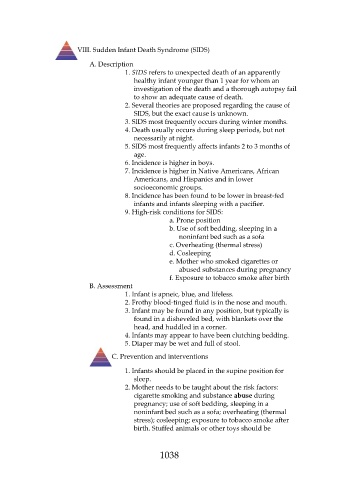Page 1038 - Saunders Comprehensive Review For NCLEX-RN
P. 1038
VIII. Sudden Infant Death Syndrome (SIDS)
A. Description
1. SIDS refers to unexpected death of an apparently
healthy infant younger than 1 year for whom an
investigation of the death and a thorough autopsy fail
to show an adequate cause of death.
2. Several theories are proposed regarding the cause of
SIDS, but the exact cause is unknown.
3. SIDS most frequently occurs during winter months.
4. Death usually occurs during sleep periods, but not
necessarily at night.
5. SIDS most frequently affects infants 2 to 3 months of
age.
6. Incidence is higher in boys.
7. Incidence is higher in Native Americans, African
Americans, and Hispanics and in lower
socioeconomic groups.
8. Incidence has been found to be lower in breast-fed
infants and infants sleeping with a pacifier.
9. High-risk conditions for SIDS:
a. Prone position
b. Use of soft bedding, sleeping in a
noninfant bed such as a sofa
c. Overheating (thermal stress)
d. Cosleeping
e. Mother who smoked cigarettes or
abused substances during pregnancy
f. Exposure to tobacco smoke after birth
B. Assessment
1. Infant is apneic, blue, and lifeless.
2. Frothy blood-tinged fluid is in the nose and mouth.
3. Infant may be found in any position, but typically is
found in a disheveled bed, with blankets over the
head, and huddled in a corner.
4. Infants may appear to have been clutching bedding.
5. Diaper may be wet and full of stool.
C. Prevention and interventions
1. Infants should be placed in the supine position for
sleep.
2. Mother needs to be taught about the risk factors:
cigarette smoking and substance abuse during
pregnancy; use of soft bedding, sleeping in a
noninfant bed such as a sofa; overheating (thermal
stress); cosleeping; exposure to tobacco smoke after
birth. Stuffed animals or other toys should be
1038

